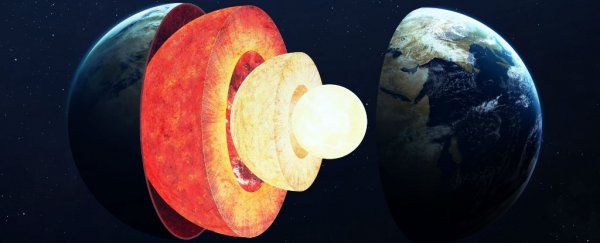The ground isn't as solid as we'd like to think. It's split into interlocking puzzle pieces called tectonic plates that ride on top of an underlying layer of rock known as the mantle. Where those plates collide, it produces fault lines and volcanoes, so understanding the movement of the mantle could someday lead to advances in our ability to predict earthquakes and eruptions.
It's hard seeing beneath those plates, though, so there's a lot we still don't know about the mantle of our home planet. But researchers in the UK have just made a big step forward in understanding and modelling how the mantle moves. It turns out that it's much more dynamic than we thought.
The mantle is a huge layer of solid rock about 3,000 kilometres thick, that over the course of millions of years, moves a bit like a really thick liquid. The crust (where we live) floats on top of the mantle - so it moves when the mantle moves.
In the past, scientists mostly focused on the mantle's side-to-side motion, which is what moves tectonic plates around and rams them together to cause earthquakes, mountain ranges, trenches, and volcanoes.
The sideways motion is strong enough to move whole continents around, but it can also vary over just a couple thousand kilometres - meaning that if you go a few thousand kilometres from where you're sitting, you might end up where the mantle is dragging the crust in a different direction.
That combination made it seem like most of the mantle's movement went into pulling the crust around, so scientists hadn't focused very much on the other direction: towards or away from the planet's core. It seemed like there wasn't much of this vertical motion going on around the world, and that it could only cause small changes at most.
New research by a team from the University of Cambridge suggests that this isn't the case. The group used data from over 2,000 sites around the world to measure the amount of vertical movement in the mantle, and they found that it's much more common than anyone thought.
Instead of slowly varying over tens of thousands of kilometres like earlier models predicted, it changes over only a couple thousand kilometres, just like the sideways motion does. And that's a huge difference.
They also found that it has much bigger effects than those models had predicted. The mantle can push or pull a piece of the crust a kilometre or more out of line with the crust around it.
So if you're in Hawaii, where the mantle is pushing up, you're about a kilometre farther from the core than you otherwise would be. And if you're in eastern South America, you're about a kilometre closer to Earth's core than you would be without the mantle pulling on the crust beneath your feet.
The team discovered this primarily by comparing the crust's thickness to its age. With those data in hand, they could figure out how much of the crust's topography - the way its height varies across Earth's surface - was due to things like plate tectonics, and how much of it was due to the crust actually being pushed up or pulled down by the underlying mantle.
But they didn't stop there. They were also able to describe their findings mathematically with a new model of the way temperature variations in the mantle change its movement. This model and these measurements give researchers a much better idea of what's going on in the mantle than they've ever had before.
The new model, which has been published in Nature Geoscience, isn't going to be predicting earthquakes or eruptions any time soon, but it's a great advance in our knowledge of the inner workings of the planet that we all share. And sometimes, that's all you need.
